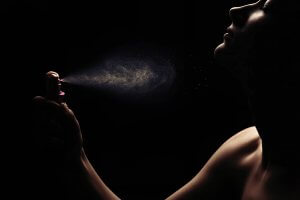Perfume has a soul all its own, and in its infinite mystery and varieties, its essence creates a profoundly diverse experience for any one who wears it.
The chemicals in our bodies affect how we perceive scent, and when they fuse with the compounds found in the fine perfumes, a kaleidoscope of sensations occur.
Skin type, pH levels or body temperature, which is unique for each person, can affect absorption levels and empower the possibility that the same fragrance worn by two different people can smell entirely different.
Noses, ears and eyes have varying degrees of sensitivity and some humans can smell with arcane precision.
Others, however, do not have this ability. It may seem strange that sometimes others can smell a perfume, while the wearer cannot.
This phenomenon relates to the primal instinct to survive, and dates back to the days when the world was young.
Early populations became familiar with the scents surrounding their lives and were able to easily distinguish them from others that smelled bad and/or foretold danger such as: approaching enemies, smoke and fire.

Understanding pH Levels And Their Connection To Perfume
The moniker, pH, stands for potential hydrogen and refers to how acidic a particular substance, such as skin, may be.
This acidity helps maintain the balance of natural oils and protects it from harmful bacteria.
Everyone’s skin has its own level, and pH is measured by the numbers 0-14, with 7 representing a neutral pH. The lower the number, the more acidic it is.
The most desired pH value on our faces and bodies lies between 4.7 and 5.75.
A grade below is acidic and above is alkaline, both of which, according to dermatologist resident, Taylor Bullock, “can cause acne, flakiness or dryness because it disrupts the skin’s natural micro environment where normal, healthy bacteria don’t thrive and the skin barrier doesn’t work as well.”

Skin Types And Perfume Designing
Appearance, style and personality are all intensified with that perfect fragrance.
Due to the myriad of possibilities, a selection that is best suited for a particular skin type can be challenging and overwhelming.
Skin type, whether oily, dry or a combination of both, is a major factor in the perfume experience.
The chemical fusion of skin and perfume will determine its ultimate spirit.
Understanding how this happens opens up new doors to both consumers and perfume manufacturers developing a fragrance line.
For master perfumers, the process of creating a fragrance often involves testing formulas on multiple skin types and paper.
This testing is important because every person’s nose, skin and personal preferences can vary dramatically.
A skilled perfumer will collect all of the results and then adjust a formula so the composition works for as many people (and skin types) as possible, while keeping to the vision established within a fragrance brief.

For consumers, it can be rewarding to enhance both a body’s natural scent and gain confidence in the expression of individuality.
The selection of perfume becomes an educated decision armed with the knowledge that a beloved scent may simply not work. The three categories are oily, dry and normal, which is a combination of both.
Each requires a different kind of perfume that will best accommodate specifications. More on each follows below.
Oily Skin
This skin type has a higher moisture content than the other two.
Due to its abundance of sebum, which is a substance produced by the sebaceous glands that lie in the middle layers of the epidermis, oily skin is known to retain and intensify fragrance.
The reason for this is because the oils on skin capture and retain scent molecules, heightening the longevity of a particular fragrance.
Our perfume formulators develop scents for oily skin by utilizing citrus facets such as: invigorating grapefruit, fresh, clean lemon and spicy, complex and elegant bergamot.
A refreshing, astringent nature provides the ideal natural weapon for combatting excess oil and balancing its production.
According to Michael Donovan, founder and creative director of the London-based perfume line, St Giles: “…The general rule is that oily skin makes fragrances pop. Sweet notes, I have found, can be overwhelming and almost sickly on oily skins… They can turn quite modest, discreet scents into a magnum opus…Perfumes tend to last longer and smell more intense on oily skin because the skin oils capture and hold fragrance molecules …”
Dry Skin
Fragrances applied to dry skin tend to be less intense and evaporate more quickly.
A wearer may need to re apply it several times during the day.
Michael Donovan explains: “Dry skin needs bigger fragrances with a good solid base to hold up the fragrance and make it last. Orientals and chypres work well, as do spices and the heavier blooms like tuberose. The delicate scents will disappear…”
Fragrances containing sandalwood are ideal for this skin type. Exotic, warming and woody, this warm and woody facet is a natural moisturizer that helps skin remain hydrated and supple.
Vanilla is another splendid ingredient, both for its lush, ambrosial scent and antioxidant properties that can help protect skin from environmental stressors.
Master perfumers recommend always moisturizing before applying a perfume to dry skin.
Normal Skin
This type of skin, which is not too oily or too dry, is a perfumer’s dream because most scents will tend to remain true to their original composition.
Masters rely on facets like rosemary, which not only adds an earthy, woody tone, but also helps to balance both dry and oily skin areas.
The soft, sweet addition of Ylang-ylang also complements this skin category.
Other Factors That Influence Perfume Reactions
Environmental issues such as: humidity, temperature, wind, cold and sun can affect the lifetime of a particular perfume.
Cold weather acts as a natural fixative while heat can cause rapid evaporation rates.
Diet and mode of application can also influence the smell of perfume. Strongly flavored foods, such as garlic and heavy spices, blend with other facets and create a unique formulation.
Body chemistry influenced by diet can alter body odor, which in turn interacts with perfume and mutates its general character. Rubbing in the scent as little as possible expedites osmosis, which will permit a perfume to linger on the surface of the skin.
Michael Donovan states: “Edible perfumes, otherwise known as herb and spices, can change how a perfume smells.
Hormones can greatly alter a perfume’s intrinsic nature.
When estrogen levels drop, which occurs about three weeks into a cycle, a woman may become overheated more easily and sweat a little more, which in turn will affect whatever perfume she may be wearing.
One study confirmed that people are drawn to scents that will work with their natural body odor.”
The Individual Essence of Perfume
There are few things more personal than the selection of perfume.
If it does not mirror the personality, style, mood and age of the wearer from the very first time it is experienced, it is not the right choice.

All perfumes are comprised of hundreds of chemical compounds, making it impossible for one scent to work for everyone.
Inherently mystical and aesthetic, their essence is based on science, chemistry and artistry.
At the heart of every composition lies the undeniable fact that “no one size fits all.”
It is this intangible factor that sustains perfume’s enduring fascination and allure.
Scent can teleport to another time and space, and is uniquely able to evoke emotion and nostalgia.
Human perception and the subconscious are integral to our sensations and feelings about whether a perfume will be loved, tolerated or hated.

Fragrance vs Essence
This is an important distinction. A fragrance is a one-of-a-kind combination of essences and an aroma is the same thing, but is usually related to a specific food scent.
According to the International Fragrance Association, “fragrance is a chemical mixture that has a smell or odor…The mixtures that make a fragrance may include natural aromatic raw materials obtained from plants using distillation, expression and extraction or synthetic materials.”
While scents are known to feature natural ingredients, that are further synthesized in a laboratory, they often contain artificial elements, that due to a lack of governmental regulation, are not always made known to the public at large.
The essence of a fragrance is complex and refers to the particular aromatic compounds (essential oils) used in a specific perfume.
They contain concentrated properties along with water and alcohol, which collectively determine the longevity of a fragrance.
The National Institute of Environmental Health Services defines essence as: “essential oils, which are obtained through mechanical pressing or distillation.
They are concentrated plant extracts that retain the natural smell and flavor of their source.”
In Conclusion
If you have your own perfume line or you are thinking about creating one, bear in mind the aforesaid information — it can only help to streamline and enhance compositions.
Or do what most do and lean into our decades-long perfume manufacturing experience and let us create your next successful fragrance!

 alpha aromatics®
alpha aromatics®